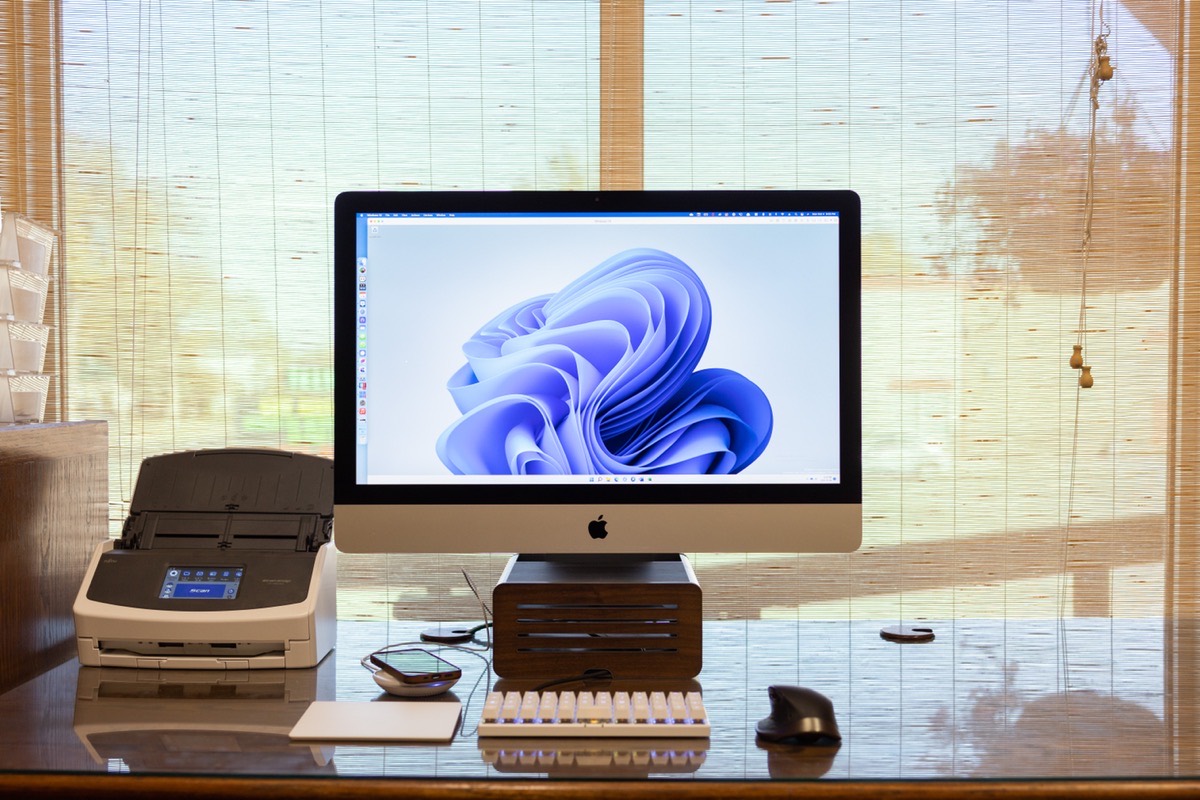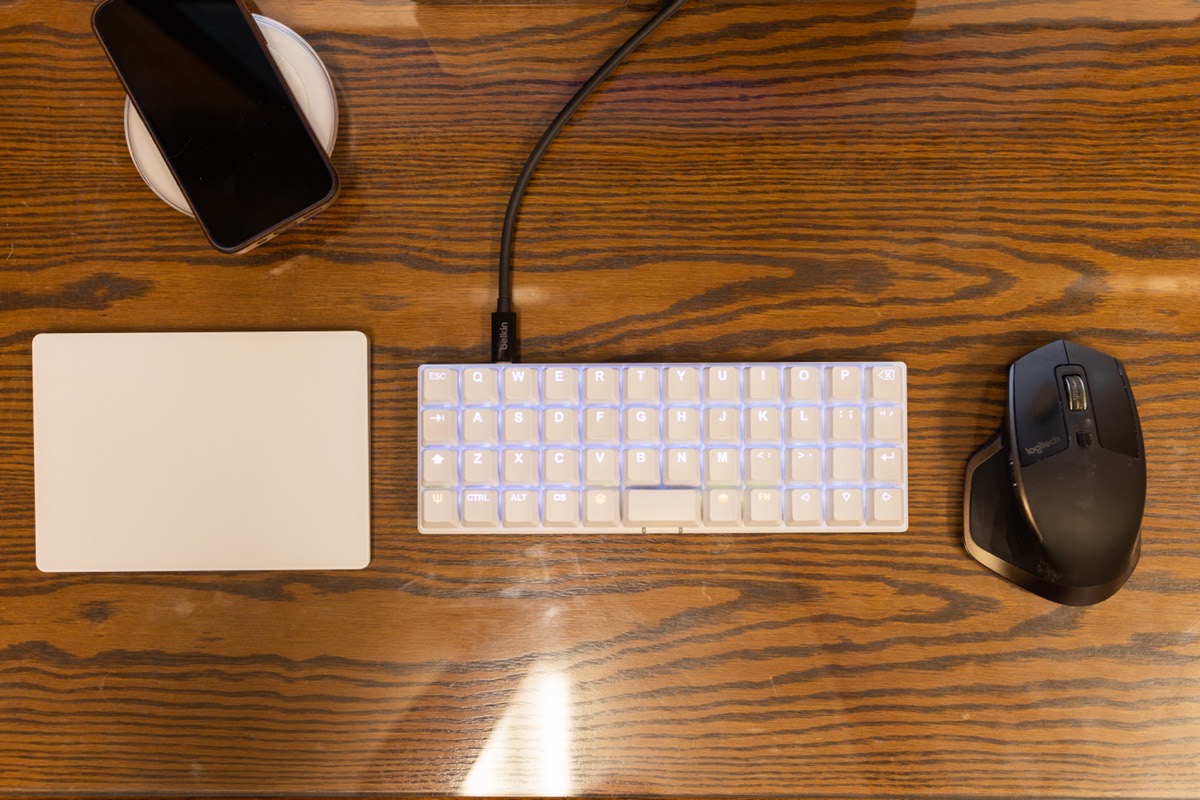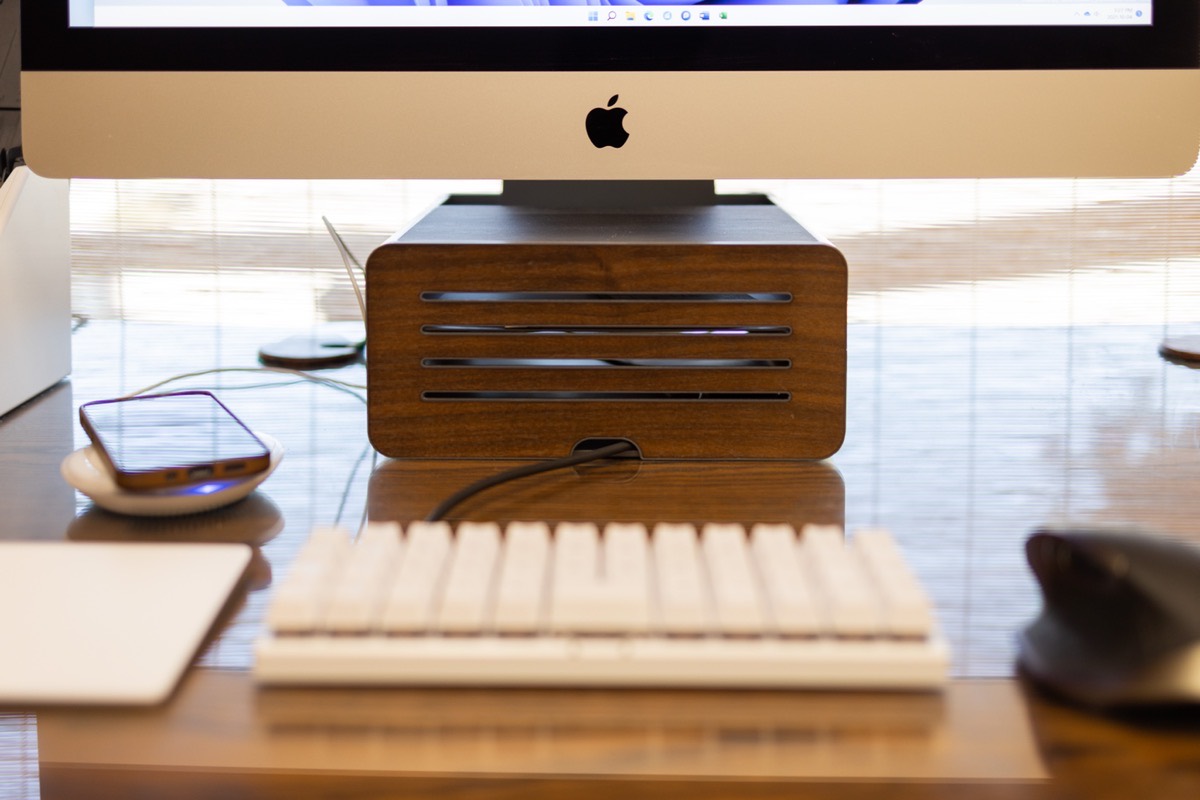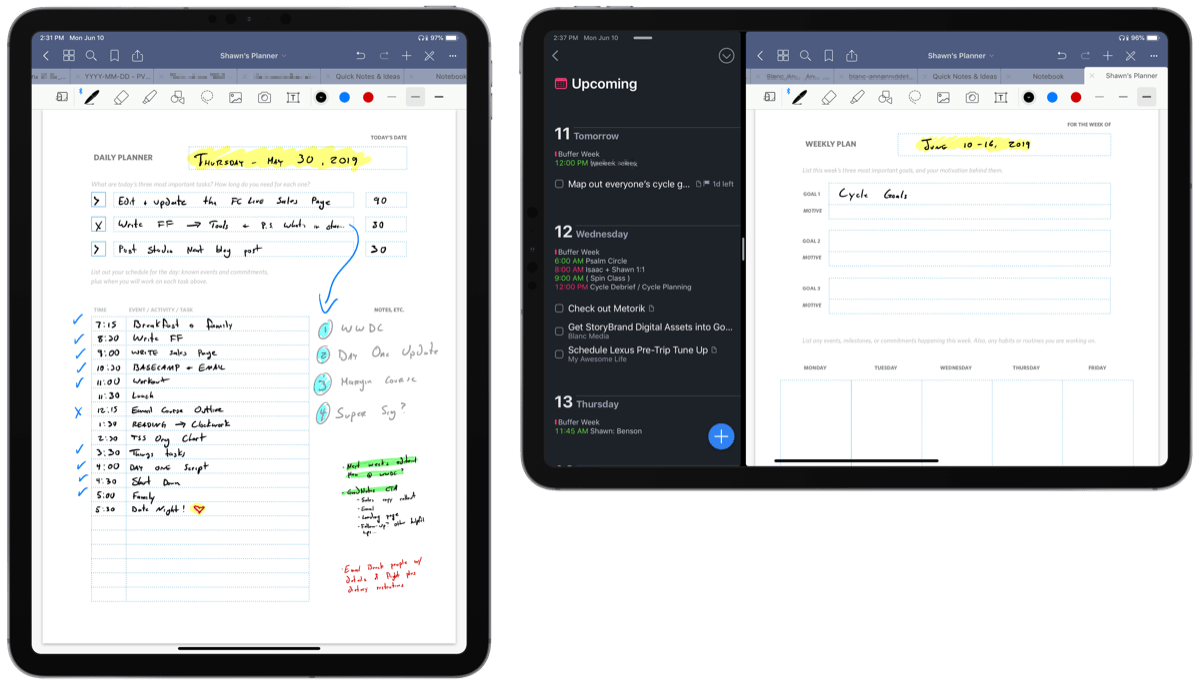Josh Ginter’s iMac Setup for Accounting
In this series, we post a new interview with someone about what software they use on their Mac, iPhone, or iPad. We do these interviews because not only are they fun, but a glimpse into what tools someone uses and how they use those tools can spark our imagination and give us an idea or insight into how we can do things better.
New setup interviews are posted every Monday; follow us on RSS or Twitter to stay up to date.
Who are you and what do you do?
I’m Josh Ginter, a new CPA located in Morden, Manitoba, Canada. I’m also the managing editor here at The Sweet Setup. I have two beautiful, rambunctious little girls, a patient wife, and a busy work schedule requiring constant calendar organization.
I have long worked on Macs, iPads, and iPhones for The Sweet Setup, but I was only able to transition to a Mac at the accounting office in the last year or so. It has been a year of testing new workflows and software. I’ve settled on an Intel iMac setup (for now) that has actually improved my productivity over past PC setups.
What is your current setup?

On top of my current desk sits:
- 27-inch iMac (2019) — 3 GHz 6-core Intel Core i5, 24GB RAM, Radeon Pro 570X 4 GB VRAM, 512GB SSD
- ZSA Planck EZ Mechanical Keyboard — Kailh Thick Gold switches
- Apple Magic Trackpad
- Logitech MX Master Mouse
- Twelve South HiRise Pro Stand
- Fujitsu ScanSnap iX 1500 Scanner
- A very old Samsung Qi wireless charger


I sit in a Herman Miller Aeron chair and my desk is an original, state-of-the-art antique that is in desperate need of replacing.
I also generally connect an M1 iPad Pro to my iMac throughout the day, but we’re not touching on iOS or iPadOS today.
I long for a second 27-inch display on an ergonomic arm that I can rotate for clients to look at their tax returns or financial information during a meeting, or just for spreading out digital documentation across twice the screen space. We’ll see what Apple’s October event brings.
I’m currently using an Intel-based iMac because of my work inside Parallels and Windows. I tested my office workflow on an M1 MacBook Air and it performed better in most ways running the ARM-version of the Windows 11 Insider Preview. All software I require each day worked on ARM Windows 11 except for Microsoft Excel and Word. There are ARM-versions of Excel and Word to test of course, and I can install macOS versions of Excel and Word no problem, but other Windows-only software broke when exporting reports to Excel or Word.
Long story short, I’m using an Intel-based Mac until full production versions of ARM Windows 11 and ARM Office apps are available. Perhaps both are available by the time this interview releases!
Where can we find your macOS wallpaper?
The Windows 11 Insider Preview inside a Parallels virtual machine has the default Windows 11 wallpaper. You can find it here. My macOS wallpaper of choice is Aqueux, made by Hector Simpson.
What software do you use and for what do you use it?
So the cool part about running two operating systems is that I can split my most-used software onto the platform where the software performs best. For instance, Microsoft Word and Excel have more features and perform better inside the Parallels VM than they do as native macOS apps. Also, two operating systems allows for two separate docks for organizing all my apps.
Let’s go!
First, my macOS dock includes:
- iStatistica Pro — Basically, this is my glorified Activity Monitor. iStatistica looks better than Activity Monitor, even though I still have to dive into Activity Monitor occasionally to force quite apps.
- Pastebot — My clipboard manager of choice. I also have a few snippets saved in Pastebot for quickly renaming files, though I suspect these would be better used inside Alfred 3.
- Calcbot — Microsoft Excel is the world’s greatest calculator. But sometimes, Excel is a little too big for running simple addition. For those simple arithmetic calculations, Calcbot has just enough whimsy to keep me smiling.
- Fantastical 3 — I recently subscribed to Flexibits Premium package to allow for proposed events inside Fantastical 3. I am unsure how this will work inside an office where everyone else uses Exchange on a Windows PC, but I expect my tax season scheduling will be world’s better in 2022 than in 2021.
- Things 3 — My GTD app of choice, and has been since it debuted in 2017. All tasks for my life go into Things and simple tag filtering allows for honing in on office-specific tasks during the day.
- Safari — Safari is my browser, but mostly because it’s just baked into macOS everywhere. Safari isn’t a hill I will die on, generally. It’s just there on every device I own, so I use it on the Mac as well. I do have to use Google Chrome for a specific web-application, however, so I don’t use Safari for everything.
- HEY — My personal email client. I’m not sure if I’d double-down on HEY for Work, mind you. It’s just different enough to probably be a non-starter for the other folks in the office.
- Mail — My work email client. I’ve tried so many different email apps on the Mac, and yet I still land on Mail. I think I just prefer the simplicity of its design.
- Messages — For communicating with clients, family, and friends during the day.
- WhatsApp — For communicating with clients and specific group chats.
- Signal — For communicating with clients and specific group chats.
- Quill — For communicating with a specific group chat.
- Craft — Craft is sort of my work notes repository and daily work tracker. I have client pages that I link to from Craft’s Daily Notes feature each day with the work I’ve finished. I also have valuable notes and other work documentation saved inside Craft. Whether Craft sticks for the long run is a legitimate question though — I’d like to move forward with this sort of workflow across our office and I think Notion may be the best option for this.
- Tweetbot — My guilty indulgence. But honestly, Twitter has been invaluable for finding breaking news and finding great insight into the world around me. I don’t think I want to be rid of Twitter. I just need to better manage my “Just Checks”.
- Parallels 17 — The best option for running Windows on a Mac right now. And Parallels only gets better, it seems. I run the Parallels Windows 11 virtual machine as its own window most of the time. However, Parallels’ Coherence Mode works great for putting macOS and Windows apps side-by-side if you require software on both platforms.
Evidently, I do a lot of communicating on my Mac each day. HEY, Mail, Messages, WhatsApp, Signal, Quill, and to an extent Tweetbot all perform effectively the same task: communication. I want to be as available to clients as possible across as many platforms as possible. And this is, well, the result. This doesn’t even include Slack!
I’d love for there to be a one-app solution for this, but I don’t think there is. Further, I don’t know if I can keep up the correspondence pace as I grow into the future. I could probably message people all day, every day, and never get any other work done.
Other macOS apps I use regularly include:
- 1Password 7 — This is one of the workflows I’m most proud of for pitching and adopting in our office. Our office’s security has become top of mind and 1Password is a core piece of that. Our passwords are randomized and very, very long now, and I legitimately could not even start my day without it.
- Alfred 4 — If there’s one app that I point to when I want to convince my colleagues to switch to a Mac, it’s Alfred 4. Perhaps something like Alfred exists for Windows, but Alfred is a superpower for knowledge workers. Of the 1,000 or so client folders our small office has, I can jump into any of them with a simple Alfred search. There’s no clicking or dragging or dropping or anything. My boss always comments on how quickly I can jump into specific files, and it’s all thanks to Alfred.
- Microsoft OneDrive — We’re an accounting office, so naturally we are Microsoft Office subscribers and heavy Microsoft Office users. There are surely better cloud storage options that are better than OneDrive (the app barely works on a Mac at all), but this one is baked into our subscription and allows for direct collaboration inside Word and Excel. We put up with OneDrive’s faults and are thankful for its surprises.
- CaseWare RCT — CaseWare RCT is a web application that houses all our office’s engagement and financial statement work. This is another one of those pitch-and-adopt accomplishments I’m proud of. RCT isn’t perfect and its constant updates result in bugs that have nearly broken financial statements right before finalization. But the completeness of the workflow, which is derived directly from CPA Canada’s standards, is an amazing thing for a checklist-heavy profession like ours.
- Banktivity — I can take my pick of any piece of accounting software to stay on top of my own personal finances. Banktivity is my pick for the task. By and large, I could use any personal finance app, but I really like how Banktivity also sports portfolio tracking alongside expense tracking.
- Cardhop — For managing contacts and for occasionally remembering specific tidbits about clients so I can appear extra-observant each time I correspond with someone.
- Cleanshot X — I have been using Cleanshot for years and it’s probably the single utility every single Mac owner should own. Cleanshot takes screenshots like its on steroids. It’s so easy to snap a screenshot free of a cluttered desktop and send it off to a client thanks to Cleanshot. The built-in screenshot maker just isn’t the same.
- Google Chrome — For a short while in the past, CaseWare RCT just wouldn’t work for me inside Safari. Maybe it still doesn’t work in Safari. I moved over to Google Chrome for CaseWare RCT at that point and I haven’t looked back.
- Screens 4 — We’re in a slower work cycle right now, but tax season from January to June is very, very heavy. For those times, I need to be able to work from home and beam into my work iMac for software I can’t access via browser. It took a little while to get Screens to work. Once I got it firing though, Screens has been incredible to work with. I just wish there was a smoother way to work on a large 27-inch display from a smaller 13-inch display on a MacBook Air. Text is just too small!
I recently updated to the Windows 11 Insider Preview in Parallels 17 to test the OS ahead of time and ensure all our accounting and tax software worked as advertised. Everything works, and arguably better than on Windows 10. Windows 11 also happens to look fantastic on this big 27-inch iMac display — dare I say, better than macOS.
I have subscribed to Parallels 17 Desktop Pro Edition, allowing for customized allocation of hardware to the Windows virtual machine. My hardware allocations to the VM are as follows:
- Two (2) processor cores
- Twelve (12) GB RAM
- Graphics processing setting at “Best for external displays”
- Two hundred fifty-six (256) GB of SSD capacity
The Windows 11 VM and macOS share files back and forth automatically. I can open an Excel document inside the Windows VM from macOS’s finder and I can open PDFs inside macOS’s Preview from Windows Explorer.
My Windows 11 dock includes:
- Windows Explorer — For navigating all the same file folders as inside Finder. Generally, I go this route if I’m opening a file pertaining to any of the Windows-specific apps below.
- Microsoft Edge — Because it’s so baked into Windows 11, I guess? Sometimes it’s just easier to have a browser inside the Windows VM, and Edge is my choice.
- Sage 50 Quantum Accounting — Our preferred accounting software. Sage 50 is Windows-only, so this is Part 1 of 2 reasons why I need to work inside a Windows VM. Quickbooks Online has come a long, long way, which would enable us to work inside a browser. But old habits die really, really hard.
- Intuit ProFile — Our office’s tax preparation software. I could write an entire essay on ProFile. Please, someone, please create a powerful piece of Windows or Mac tax software that can replace ProFile.
- Microsoft Word — I’ve written an entire piece on why I think it’s better to run Word and Excel inside a Windows VM rather than through the native Mac app. Word isn’t as big an improvement as Excel inside the VM, but having them work side-by-side is a very nice luxury.
- Microsoft Excel — If you meet an accountant who doesn’t spend their day in Excel, give me their contact information so they can explain to me how they get their work done in a day.
In general, I attempt to keep the amount of apps and workflow inside the Windows VM to a minimum. However, I also use an older version of Foxit PhantomPDF for all our PDF work in the office. Preview is faster because it’s native, but Foxit has some extra editing features that make it our go-to PDF app in the office. This version of Foxit happened to be another backbreaker for my M1 MacBook Air experiment — Foxit PhantomPDF 9 is not ARM-ready, and so I required the latest version of Foxit (or some other PDF option) to edit PDFs on the MacBook Air.
How would your ideal setup look and function
Like any professional office out there, ours moves forward patiently when it comes to computer changes and desk setups. The setup shown here — not including the iMac — is the same desk and setup I’ve had since I started in 2013.
But I’m sort of antsy for a new setup, so hopefully my dreams can become a reality soon enough.
My ideal setup would be a 13-inch MacBook Pro that is capable of running two 27-inch displays. There’s an Intel-based 13-inch MacBook Pro capable of this right now, but I’m hesitant to double-down on an Intel-based Mac given the inevitable Apple M-chip future. I’d like a laptop so I could work from home in the evenings during tax season rather than beaming in via Screens from my home office M1 MacBook Air.
We’ll see what we get in the near future, but having to split hardware between macOS and a Windows 11 VM means I’d like to have as much excess capacity in my machine as possible. Intuit’s ProFile app absolutely devours RAM, often causing my former 32GB Lenovo ThinkPad to crash after four or five tax returns were opened. Memory management seems to be better on the Mac and this hasn’t happened consistently with the 12GB RAM dedicated to the Windows 11 VM on my iMac. However, it has happened once or twice. As such, I’d like a 32GB MacBook Pro at least — 64GB of RAM would be best.
I use my own iPad for reading, messaging, emailing, and the occasional digital signature, but I’d like to move our entire office to iPads with Apple Pencils for digital signatures and forms. We absolutely rip through paper reams in our profession. I’d like to curb that a bit with a more digital workflow.
I transplanted my own Herman Miller Aeron chair a few years ago and the ergonomic improvement was immediate, so I think an L-shaped standing desk (perhaps like this one from Fully) and a few display-mounting arms would be ideal. I’d also like a new credenza, new client chairs, a small circular conference table, and a mounted flatscreen television for keeping up on the stock market during the day.
Hey, you asked me for my ideal setup. That’s my ideal setup. Basically everything would be new.
There are more Sweet Setup interviews right here.
Want to share your setup? We’d love to hear from you. Just fill out this form with some basic information and we’ll be in touch.
Wait. There’s a Bonus….
Custom Productivity Templates
We have a set of custom productivity templates that work well with the iPad app, GoodNotes. And if you want to try them out, we’ve put together a free guide that can help you.
We’ll show you…
- How to create and save custom page templates in GoodNotes.
- How to use those page templates to transform GoodNotes into your own productivity notebook (or any other type of notebook replacement).
Plus, we also have included a couple of our custom productivity templates for you to get started with. These templates are right out of our popular productivity course.

The custom templates and the guide are available for FREE to our email subscriber community. And you can get it right now. By joining the Sweet Setup community you’ll also get access to our other guides, early previews to big new reviews and workflow articles we are working on, weekly roundups of our best content, and more.
